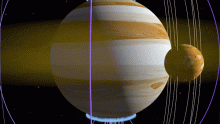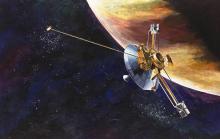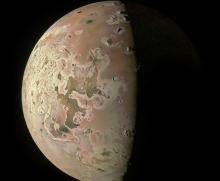Listen to today's episode of StarDate on the web the same day it airs in high-quality streaming audio without any extra ads or announcements. Choose a $8 one-month pass, or listen every day for a year for just $30.
You are here
Moon and Jupiter
The planet Jupiter is about to end another long trek across the night sky. The planet will drop from view in the evening twilight in two or three weeks. It then will pass behind the Sun before returning to view in April — in the morning sky.
This evening, though, Jupiter is in great view — it teams up with the crescent Moon. It’s close to the upper right of the Moon as the sky begins to darken, and looks like a bright star. Jupiter and the Moon set a couple of hours after sunset.
Jupiter has two different motions across the starry background. One is caused by Earth’s motion around the Sun. As we orbit the Sun, our viewing angle to the stars and planets changes. So each of them appears to progress across the sky as the nights roll by. Jupiter first appears at dawn, then rises and sets earlier each night. Over the months, it travels across the sky, until it sets with the setting Sun.
The other motion is caused by Jupiter’s own orbit around the Sun. The planet is more than five times farther from the Sun than Earth is. At that distance, Jupiter takes almost 12 years to complete a single orbit. And that’s also how long it takes to move through the constellations and return to the same spot in the sky relative to the stars. So on February 2nd of 2034, Jupiter will stand at almost the same spot in the sky as tonight — getting ready to disappear once more in the evening twilight.
Script by Damond Benningfield





